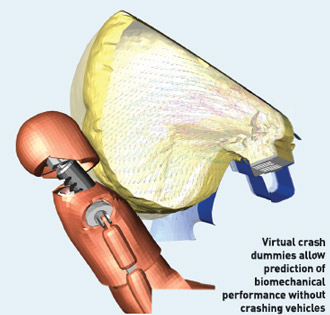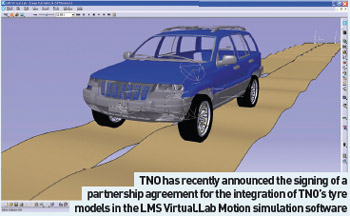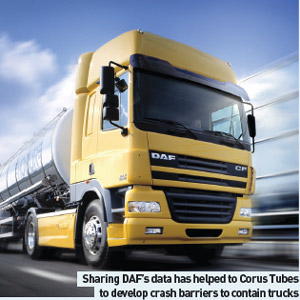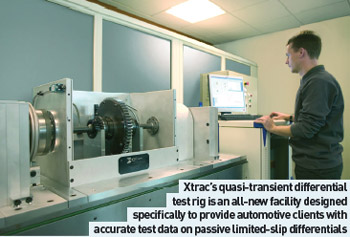Computer aided engineering is making vehicles safer through the use of more sophisticated simulation models based on reliable data. AMS looks at the rise of the digital dummy.
Corus, the international steel company, and DAF Trucks, one of Europe’s leading truck manufacturers, have collaborated to develop a unique computer simulation crash model which they believe will lead to safer future truck designs.
With road freight increasing across Europe there is a growing pressure on manufacturers to design safer trucks that protect both the driver and other road users.
Improving the performance and truck containment of modern roadside crash barrier systems is also an area that can greatly contribute to increased road safety.
The collaboration has brought together DAF’s marketleading design capabilities with Corus’ materials knowledge, advanced computer modelling expertise and, importantly, over 40 years experience designing, manufacturing and supplying roadside crash barrier systems.
DAF supplied its latest engineering data to Corus Tubes, based in Corby, UK and together they have been able to develop a sophisticated crash simulation model, which has led to the development of a class-leading high containment barrier system for commercial vehicles. Importantly, the collaboration now provides DAF with access to this crash simulation model based on the latest engineering data.
This can be used to enhance their own evaluation during the development of new truck models.
 A major advantage of utilising this latest Computer Aided Engineering (CAE) technology is that engineers can quickly evaluate reiterations to optimise new model design. Reducing the reliance on physical crash testing will provide benefits to both DAF and Corus in the reduction of both development time and costs.
A major advantage of utilising this latest Computer Aided Engineering (CAE) technology is that engineers can quickly evaluate reiterations to optimise new model design. Reducing the reliance on physical crash testing will provide benefits to both DAF and Corus in the reduction of both development time and costs.
“While using CAE simulation techniques is now standard practice in truck design, by working with Corus, this unique crash simulation model has enabled us to go one step further,” says Henk Voets of DAF Trucks in Eindhoven.
“More stringent legislation has placed higher demands on the containment capabilities of today’s roadside barrier systems, which is helping to make roads safer across Europe. Corus’s crash simulation model will help us to understand how future truck designs perform against these systems, enabling us to optimise designs so they work even better by maximising the performance of crash containment areas on the vehicle.”
According to Ramsey Ross, Director of Market and Business Development at Corus: “As one of Europe’s leading manufacturers and suppliers of steel roadside barriers and parapet systems, it’s important that we have access to the latest engineering data to help us improve both the design and material specification of crash barrier systems.
By working with a leading truck manufacturer like DAF, Corus can obtain access to this data which allows us to continue developing new technologies and materials.”
The availability of reliable data is what sets TASS apart in developing vehicle safety systems. TASS stands for TNO Automotive Safety Solutions. TNO Automotive is a specialised research institute within the Science and Industry group at the independent Dutch R&D company TNO. The overall objective at TASS is to provide knowledgebased solutions to the international transport industry, its suppliers and other organisations concerned with safety.
It is a specialist supplier of injury prevention knowledge and products for all modes of transport.
TASS’s proprietary biomechanical database is linked to unique crash simulation software, MADYMO. “The main reason for our continued success is that the worldwide automotive safety legislation is primarily written around biomechanical performance, and our core technology – our virtual crash test dummy database – allows us to predict biomechanical performance very accurately and quickly,” says John Cooper, CEO of TASS. “Because we are able to provide time-efficient virtual solutions within the design cycle that meet the safety requirements of our customers, our solution continues to be essential to our customers and the industry."
The increasing complexity of modern vehicles needs increasingly sophisticated finite element models. This means that whole vehicle models are continuously growing in size (5-10 million elements are now expected in the near future).
“An issue with these new computer models is that they are ideal for verification of structural performance and they can run overnight on new hardware. But they can be limited when it comes to using them as part of a design process for the actual restraint system,” says Cooper. “Restraint system design involves iteration, change and optimisation, and single formulation overnight runs, detailed as they are, are not fast enough to be meaningful in a true design context."
In a restraint system for frontal impact there are approximately 28 different variables.
If you just look at five different values for each variable as a design parameter range, when you include European and FMVSS 208 crash test requirements, there's something like 12 design points at which you have to optimise and balance these 28 variables.
“This adds up to several million permutations, which means it is not practicable to do these sorts of runs in a design environment,” says Cooper. “And if you have five design loops, as you typically would in a design process, you have to do all that work five times over.”
The current legislation is complicated, and the level of complication is only going to increase. At the same time the available design time is reducing, as is the amount of money available for development, so the whole industry is caught in a vicious circle. In order to overcome this, designers have to use a very efficient process for design. “Which is where we come in,” says Cooper. “Our method, used in conjunction with statistical optimisation techniques, means designers can solve real safety related design problems within a realistic timeframe to a high quality.”
The TASS system uses a multi-body technique in conjunction with finite element analysis – it is a hybrid technique but it is explicitly based. “One of our major unique propositions is the fact that we have a very, very efficient solver,” says Cooper. “The difference between doing a full vehicle model with traditional finite element analysis and our hybrid process is that we are anywhere between 10 to 100 times faster, depending on the complexity.
“As a result what we do to design a restraint system for, say, frontal impact, which might take a total of about 15,000 simulations, is to do typically 400 runs a night and post-process them in a couple of hours the next day,” says Cooper. “This relatively high turn-around speed means that simulation can lead the design process. MADYMO is not just a verification tool: it's a design tool. Because traditional analysis in conjunction with testing is complex and timeconsuming, it can only really check the outcome of design decisions, rather than lead the whole design process as it should. The end result is that our solution is very strong in the safety design niche."
The future for these kinds of analyses is the real-time control of the restraint system during a crash. Early research has shown that a contemporary system with an injury index of 1.0 can be optimised with real-time control to take that level of injury down to 0.25, potentially a 75 per cent reduction in injury. More importantly, the 75 per cent reduction in injury value will produce a greater percentage reduction in the actual severity of the injury, as most of the injury values are non-linear.
This sounds like science fiction and too good to be true, but it works using a combination of pre-sensing and best practice techniques for minimising injury. Just before a crash happens, a pre-sensing system will detect an oncoming object or identify another potential collision incident and with real-time control the safety system will pre-position the occupant, using the seatbelt system, for minimum injury.
These systems can close the windows and sunroof, put the steering column in an optimum position, potentially put the seat and seatback angle in an optimal position and preposition the occupant whilst tightening the seat belt.
 As the crash was 'predicted' instead of waiting until it was sensed physically, the safety system could start to make adjustments to the total restraint system to minimise injury.
As the crash was 'predicted' instead of waiting until it was sensed physically, the safety system could start to make adjustments to the total restraint system to minimise injury.
As the crash progresses the safety system can measure the input of the crash and make appropriate changes. “The major benefit of what we do at the moment for a supplier or an OEM is that we can take out over 60 per cent of the cost of their restraint system development without compromising – and in many cases improving – overall safety,” says Cooper.
This knowledge-based approach means that everyone wins – occupant safety is greatly improved, injuries are minimised, which reduces trauma and medical costs, and OEMs and suppliers save considerable time and resources on development programmes.
TNO has recently announced the signing of a partnership agreement for the integration of TNO’s tyre models in the LMS Virtual.Lab Motion simulation software. As a result of the agreement, LMS Virtual.Lab Motion users gain access to accurate and scalable tyre models for concept studies, handling simulation, comfort analysis and fatigue prediction.
LMS will market and sell the integrated TNO MF-Tyre and MF-SWIFT modelling capabilities as an integral part of LMS Virtual.Lab Motion. The integrated solution has become available with the release of LMS Virtual.Lab Rev 6.
The TNO MF-Tyre and MF-Swift tyre models complement the existing tyre modelling capabilities in LMS Virtual.
Lab and allow users to perform accurate and realistic full vehicle simulation for key attributes like ride and handling, comfort and durability. High fidelity modelling of tyres is the prerequisite to correctly translate the impact of different road surfaces on the vehicle and to realistically simulate the vehicle’s driving behaviour. The TNO Tyre models can be applied for the dynamic simulation of passenger cars, motorcycles, trucks, industrial vehicles and aircraft landing gear.
MF-Tyre is TNO’s implementation of the world standard Pacejka Magic Formula tyre model. Its semi-empirical approach guarantees accurate handling simulation. MF-Swift is the high frequency extension to the Magic Formula MFTyre model, which mainly supports comfort and durability simulation.
Vehicle safety is behind the introduction of a new test facility from vehicle transmission and driveline specialist Xtrac.
This is believed to be the first of its kind, to help carmakers characterise the performance of passive mechanical-type limited-slip differentials.
Whether active or passive, limited-slip differentials improve the handling and safety of cars through better distribution of torque to the drive wheels, thereby enhancing acceleration, braking and cornering abilities under varying road conditions. Racecar engineers have long understood the benefit of limited slip differentials and specify them to improve the performance of race, rally and sports cars. Vehicle engineers also employ them in high performance road cars.
Xtrac’s quasi-transient differential test rig is an all-new facility designed specifically to provide automotive clients with accurate test data on passive limited-slip differentials, which despite being simpler than active differentials have until now proved almost impossible to measure because of their transient behaviour. The new rig complements Xtrac’s longstanding ability to characterise electronically-controlled hydraulically-operated active and viscous coupling differentials, henceforth providing the company with the ability to evaluate almost any type of differential system.
“We have designed and commissioned this quasi-transient test rig to support our differential design and predictive modelling capabilities,” says Xtrac Technical Director Adrian Moore. “This is a significant investment using a closed-loop torque-path concept first seen on our 4-square-gear test rig.
It will help increase our understanding and calibration of mechanical plate (MP), viscous coupling plate (VCP) and ViscoLok Plate (VLP) differentials.”
Test cell management is high on Burke E. Porter’s (Bepco) agenda. Bepco Machinery has just introduced its Host Cell Control System, a real-time mission critical controller that is capable of managing a complete test cell. The Host is a distributed site management and test authoring tool and test cell control system. It provides users with a complete suite of tools to customise tests and monitoring tools that enable them to create custom solutions. The tools include a user interface designer, a drive curve authoring tool, a test authoring tool, a data acquisition configuration tool, and a revision control. The interface designer provides a component toolbox that allows the user to ‘drag and drop’ components onto a workspace to create new screens.
This enables the user to customise the system, share customisations with others, and optimise how the user performs the work.
The drive curve authoring tools provide features for creating new or import existing drive curves and grade profiles. This makes it easy to visualise existing tests and create new ones. The test-authoring tool provides a toolbox that contains functional and logical blocks that can easily be dragged and dropped to create custom testing solutions.
This significantly reduces the amount of time that it takes to create new tests and also turns the test into an executable specification.
The data acquisition configuration tool enables means the user can customise the cell based on the test that is going to be performed. This provides customers with the flexibility to deploy the right hardware in cells on an as required basis, enabling them to perform broader ranges of tests in all of their test cells.
In order to manage this configurability and flexibility, the system has full revision control. The user can set up libraries that enable check tests in and out, to keep track of vehicle information and to maintain all of the history so that changes can be tracked and rolled back as necessary.
The success of the controller is a result of over 20 years experience in testing system design and development.
The three most common failure modes have been eliminated: CPU fan failure, hard drive failure, and corruption due to viruses. This combined with the highly optimised software control system enables a single system to sequence a test and acquire the data while simultaneously controlling the dynamometer, fan, and throttle/robot.
“At the end of the day, solutions must be able to provide customers with the ability to do more with less,” says Kevin Hykin of Bepco. “The Bepco Machinery Host CCS provides the features, flexibility, and robustness necessary to enable customers to compete in the global market.”
Mahle Powertrain has just announced Mahle Total Testing Services, to provide its customers with a comprehensive suite of testing capabilities for accurate and efficient validation of sub-system and component-level designs. Mahle Total Testing Services is based at the company’s Michigan facility.
The new testing organisation encompasses the metrological and metallurgical capabilities, advanced test equipment and data acquisition systems used in support of the existing Mahle product lines development business. These products include internal engine reciprocating and rotating components, valve train components and air and liquid management systems for all engine and vehicle markets in North America.
Customers can draw upon Mahle technical specialists’ wide range of experience to perform a variety of services at both on- and off-site testing centres. This service is aimed at a wide market from the original OEM’s and engine component suppliers through to the operating and service side of the business with commercial operators and engine re-manufacturers.
“Product design robustness, system integration and cost effectiveness are critical in today’s competitive marketplace,” says Alan McEwan, Business Development Director for Mahle Powertrain. “Total Testing Services is a strategic addition that builds on Mahle Technology’s recognised and often benchmarked capabilities in the area of product testing and analysis and allows us to extend this capability to the marketplace.”
Mahle Total Testing Services supports customers with sustainable technical and commercial solutions, including superior engineering support, design and product validation and warranty investigation, utilising on-site support, client confidential build and test areas and partnerships with accredited subcontractors where required.
Services include component-level tests, in addition to complete system level testing (typically already undertaken by Mahle Powertrain), which can deliver a number of advantages. For example, component level testing can start very early in the validation process before system testing has begun. An example of this would be a new ancillary component, which has to be mounted to a transmission, which could be rig tested in advance of installing on the transmission to determine preliminary reliability data.
Testing can continue throughout the development phase of an application. In addition, component level testing characterizes specific and individual performance and reliability requirements for that component; system-level reliability can be modelled, based on the configuration and results of component testing.
The Mahle Group recently acquired Cosworth Technology, a consultant and major supplier of powertrain and diagnostic engineering services to the global automotive industry, to create Mahle Powertrain, an international, full-service powertrain supplier. It employs 650 people at its offices in Novi, Michigan, and Northampton, Wellingborough and Worcester in the United Kingdom.




































